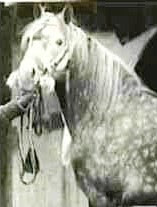 |
| *Raswan 607 (Skowronek x Rim) |
With this post, I hope to shed a little more light on the story of the Arabian stallion *Raswan, who sadly died before he could realize his full potential. It turns out that a young sculptor visited *Raswan at the Kellogg Ranch in April 1926, and captured the horse's image for a public display. It appears that there are only a few photographs of the sculptures, and as far as I have been able to tell, the sculptures and any sketches or smaller models of the images of *Raswan made by the artist are no longer with us.
In January 1926, cereal magnate W. K. Kellogg sent his stable manager, Carl Schmidt, to the renowned Crabbet Stud in England. Schmidt's mission was to purchase Arabian horses for Kellogg's ranch in Pomona, California. In April, Schmidt returned on the ship Minnewaska with fourteen Arabians and a Welsh Pony stallion. They were transferred from the ship to a Union Pacific train headed for Southern California, arriving in Pomona on April 10.
To indicate they were imported to the US, the horses' registered names included an asterisk ( * ); their American registration numbers follow their names.
The imported herd included four stallions foaled in England and two that arrived in utero and were foaled at the Kellogg Ranch. The four adult horses were:
*Nasik 604 (Rijm x Narghileh), an 18 year old bay
*Raswan 607 (Skowronek x Rim), a five year old gray
*Raseyn 597 (Skowronek x Rayya), a three year old gray half-brother to *Raswan
*Rimal 599 (Hazzam x Rim), a bay yearling
*Raseyn and *Nasik became internationally famous sires;*Rimal was gelded and sold. But at the time of the importation, the stallion who showed the most promise for Mr. Kellogg's breeding program was *Raswan. (He had already sired three purebred Arabians in England.)
Equine historian Carol Woodbridge Mulder observed:
A very high quality, beautiful horse of outstanding classic type, he was the better of the two Skowronek sons....
 |
| *Raswan, with Carl Schmidt in "desert garb" |
But that promise was never realized. Schmidt and Kellogg had a bitter dispute over who really owned *Raswan. On May 7, 1926, Schmidt rode the horse off the Kellogg property across the hills to an isolated house in Walnut, tying him by his bridle to a fence. *Raswan broke loose and ran into a hay mowing machine in a field, grievously injuring one hind foot. Veterinarians tried to save him, but they ended up having to put *Raswan down on June 12, 1926. (For details of this complex story, please see Mary Jane Parkinson's detailed description in her book Romance of the Kellogg Ranch. Mulder does a good job of summarizing the story in her article "The W. K. Kellogg Arabian Horse Ranch, Part VI -- 1926 Crabbet Purchase Males" in The Crabbet Influence, November-December 1987.)
Sadly, there are very few known photographs of *Raswan, and only one, very short, film clip of him that I could find on YouTube:
https://www.youtube.com/watch?app=desktop&v=Pa6qWvq31JU
 |
| *Raswan, in a screen grab from Lonny Hitchens' film clip on YouTube |
But that isn't the whole story of *Raswan in California. It turns out that, a couple of weeks after *Raswan arrived at the Kellogg Ranch in April 1926, a young artist sketched him and created three sculptures of *Raswan. And thanks to the resources of Cal Poly Pomona Special Collections' W. K. Kellogg Arabian Horse Library, we can connect the art and the artist to the horse.
The artist was the renowned California sculptor L. P. (Lorraine Preston) Prescott, later known as Preston L. Prescott (1898-1988). Born in Iowa, Prescott studied art in Minnesota, New York, and Los Angeles. After serving in World War I, Prescott lived at an American Legion post in Southern California for disabled veterans for a few years. Prescott worked in the film industry creating components for movie sets, and creating wax portraits of celebrities. In the 1930s he moved to Ojai, in Ventura County, where he had a well-known art studio, and in 1945 he moved to Ben Lomond, near Santa Cruz in Northern California. Prescott went on to have a distinguished career as an artist and arts educator.
In April 1926, the LA Chamber had reached out to the Kellogg Ranch, asking permission for their sculptor to visit the Ranch and make sketches of one of the horses. W. K.'s son, Dr. Karl H. Kellogg, gave his permission for the artist to sketch one of the recent imports: *Raswan.
 |
| From the collection of the W. K. Kellogg Arabian Horse Library, Cal Poly Pomona |
April 23, 1926
Los Angeles Chamber of Commerce
Los Angeles, Calif.
Gentlemen:
I am giving Mr. L. P. Prescott permission to go ahead and make sketch of Arabian horse Raswan, to be used in Grecian exhibit at Anaheim Orange Show.
Yours respectfully,
[KHK]
Sometime between April 23 and April 26, Prescott came to the Kellogg Ranch to sketch and model *Raswan. On the 26th, Chamber Secretary and General Manager Arthur G. Arnoll wrote his thanks to Mr. Kellogg:
 |
| From the collection of the W. K. Kellogg Arabian Horse Library, Cal Poly Pomona |











No comments:
Post a Comment